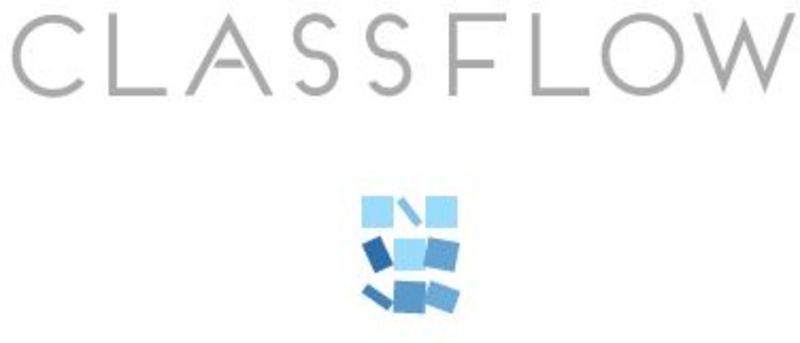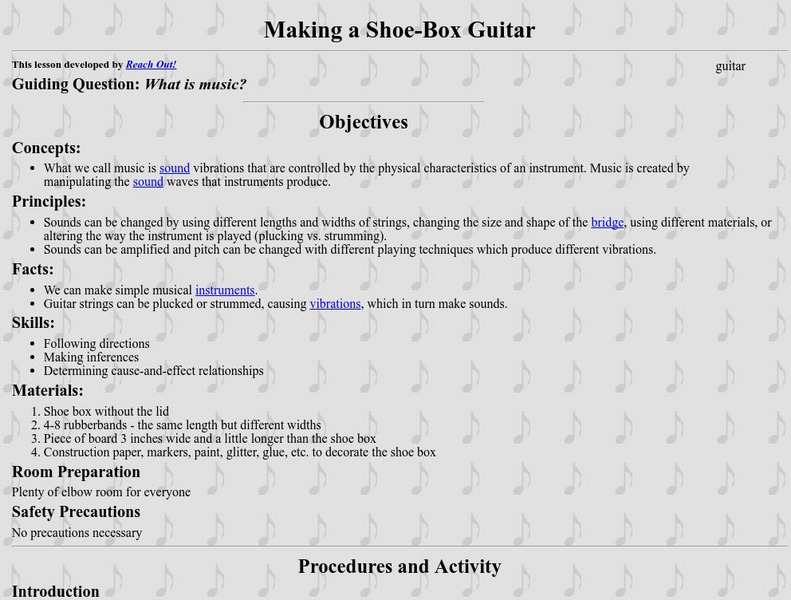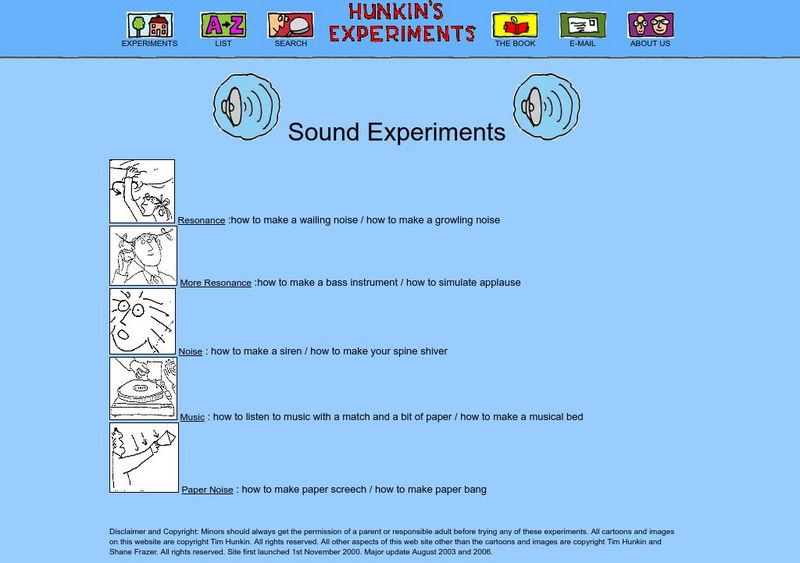Treehut
Suzy's World: Ears
Find out how your ears work and try an experiment involving your hearing.
PBS
Pbs Teachers: Scientific American: Calls of the Wild: Bats and Echolocation
Explore bats' navigation systems by experimenting with echolocation. Approximate an object's distance by analyzing reflected sound waves, measuring the delay in sound and calculating the ratio to the speed of sound.
PBS
Pbs Teachers: Scientific American: Expedition Panama: Echoes in the Night
Explore your prior knowledge about bats and investigate bats' use of echolocation to identify and catch prey. Design a game like "Marco Polo" to demonstrate echolocation.
Canada Science and Technology Museum
Canada Science and Technology Museum: Materials
Test your skill and find out which materials absorb sound well.
Sophia Learning
Sophia: Sound Waves: Lesson 2
This lesson will introduce sound waves, and describe how the amplitude and frequency can change the pitch. It is 2 of 2 in the series titled "Sound Waves."
Sophia Learning
Sophia: Sound Waves: Lesson 1
This lesson will introduce sound waves, and describe how the amplitude and frequency can change the pitch. It is 1 of 2 in the series titled "Sound Waves."
National High Magnetic Field Laboratory
Magnet Academy: Bell Telephone 1876
Acoustics, variable resistance and allegations of foul play contribute to the exciting story of the invention of the telephone.
Physics Hypertextbook
The Physics Hypertextbook: The Nature of Sound
Study the details of sound from characteristics to speed, ultrasound, infrasound, and other aspects of sound waves.
Ducksters
Ducksters: Kids Science Projects and Experiments: Sound Pitch
Kids learn by experimenting with science. Project showing how sound waves effect pitch.
Ducksters
Ducksters: Kids Science Projects and Experiments: Sound Waves
Kids learn by experimenting with science. A project showing how sound waves move and propagate.
Ducksters
Ducksters: Physics for Kids: Sound Wave Characteristics
Kids learn about the characteristics of sound waves in the science of physics including mechanical, longitudinal, pressure, and intensity.
Ducksters
Ducksters: Physics for Kids: Sound Pitch and Acoustics
Kids learn more about the science and physics of sound. Pitch, acoustics, and the doppler effect. How the frequency of the sound wave affects the pitch we hear.
Science Bob Pflugfelder
Science Bob: Make a Simple Duck Call!
Contains a procedure for using a plastic straw to create a device capable of producing a duck call when air is passed through. The site introduces the concept of vibration in sound production.
NASA
Nasa: The Space Place: Have Super Hearing With a Super Sound Cone
This site from NASA provides an interesting approach to the subject. How do messages travel in space and how do we intercept those messages on Earth? Find out the answers as well as find out how NASA's giant dish antennas work.
Curated OER
Kids Health: Taking Care of Your Ears
An informative site that deals with the parts of the ear and their functions. Text is complemented with pictures.
ClassFlow
Class Flow: The Behavior of Sound Waves
[Free Registration/Login Required] This flipchart introduces fifth grade students to what sound waves do when they encounter an object. Topics covered include diffraction, reflection, absorption, and the Doppler Effect. An assessment is...
ClassFlow
Class Flow: All About Sound
[Free Registration/Login Required] This flipchart shows the different parts of sound wavelengths and human hearing. Use the magic revealer when you learn to identify the sound canal in humans.
ClassFlow
Class Flow: Introduction to Sound
[Free Registration/Login Required] This lesson introduces fifth graders to the science of sound. Key concepts include sound waves, wavelength, amplitude, frequency, pitch, and intensity. There are many opportunities for student...
Other
Sound and Noise
There are a variety of different activities provided by this resource. Directions for designing an experiment to see if your lab partner can detect objects in a closed container based on their sound along with an activity for making a...
Science and Mathematics Initiative for Learning Enhancement (SMILE)
Smile: Sound and Vibration
Using some basic items, you can demonstrate the basic principles of sound, pitch, and vibration. This will allow the elementary student to discover some basic principles of sound and vibrations.
Michigan Reach Out
Michigan Reach Out!: Making a Shoe Box Guitar
This site provides an experiment where students create a guitar to discover what variables will change sound.
Exploratorium
Exploratorium: The Ear Guitar
This simple activity helps students understand the role of vibration in producing sound.
Hunkins Experiments
Hunkin's Experiments: Sound Experiments
Hunkin's Experiments is a group of simple cartoon illustrations of scientific principles. Some would work well in the classroom, but others have little value beyond entertaining students. All of the projects are easy to do. This group of...
Other
Confederation of Oregon School Administrators: Waves and Their Applications
Every second billions of waves-sound waves, radio waves, light waves-pass through or bounce off our bodies. Over time people have developed technologies that make use of these natural phenomena to accomplish their goals such as creating...






















